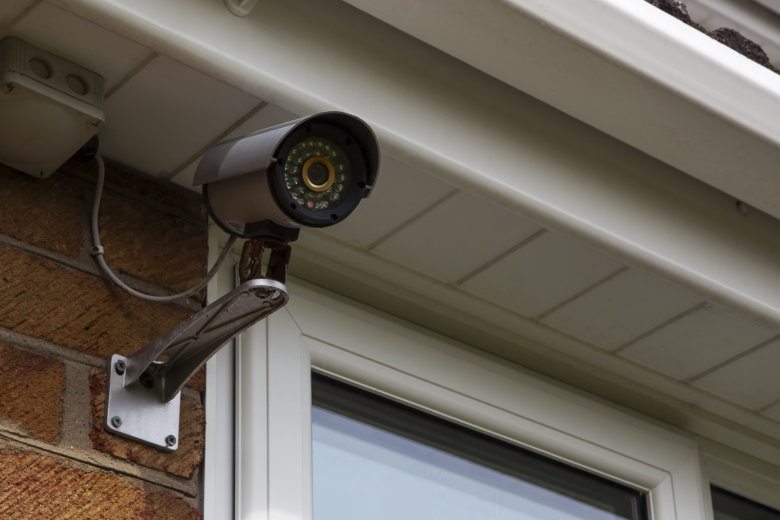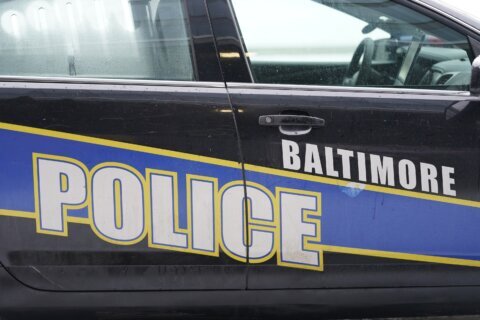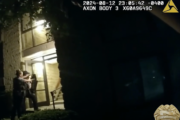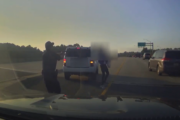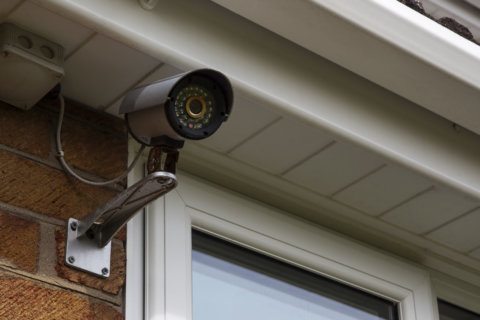
BALTIMORE (AP) — Arch McKown and his wife were out walking their dog one evening this summer when they came across a neighbor who told them he had recently been attacked by two young boys.
The man recalled how the boys threw rocks and food containers at him, and that he unsuccessfully tried chasing them down. He called police.
McKown, the Patterson Park Neighborhood Association safety chair, went home and pulled footage from his own security cameras. There it was: video of the boys fleeing. He recognized one by his shoes.
McKown’s devices are part of a broad, informal network of about 500 home cameras operating around Patterson Park. Neighbors regularly share images from their Amazon Ring, Nest or other home cameras that have become increasingly common and capture activity on porches, stoops and alleyways. The residents compare images of package thieves, carjackers, street robbers and burglars.
In some cases, the group has been able to track a criminal’s path through the neighborhood, McKown said. Neighbors’ observations have sometimes contributed to arrests. In other instances, neighbors have worked to intervene with young culprits without involving police.
As burglaries plummet around Patterson Park, police say the community watch has helped.
Neighbors often see the same faces and see patterns, McKown said.
“We realized pretty quickly that a lot of theft and crime was committed by repeat actors, so you can start to see trends,” said McKown, who works in biotech sales.
McKown said more than 200 people participate, and some houses have multiple cameras for about 500 total throughout the neighborhoods around Patterson Park.
In 2017 he and others from the community association began piecing together images using social media, information from police and crime data from the city’s Open Baltimore website. Now, when they receive information about an incident, McKown reaches out to neighbors with cameras, asking them to check their devices and whether they are willing to send footage.
“You can kind of overlay where the crimes are happening,” he said.
McKown estimated that in the past two years the network has contributed to solving dozens of cases and connected potential suspects to additional cases.
“Tangentially, it’s hundreds of cases,” McKown said.
Capt. Brian Hopkins of the Southeast District said the community has played a role in solving and preventing burglary and package theft cases.
“There’s definitely been a positive movement forward,” he said. “It’s definitely been a help … but I also think it’s a deterrent.”
Across the Southeast District, police data shows larceny is down 8% while burglaries are up 4% this year compared with the same time last year. However, McKown and Hopkins said that burglaries in neighborhoods surrounding Patterson Park are down to about half of what they were at the same time last year.
“It empowers the neighborhood,” Hopkins said. “Anytime we can have the video cameras is definitely a bonus for my detectives.”
McKown said that in some cases, residents prefer to deal with one another instead of police. He said the participation is voluntary, meaning only residents have access and can choose to retrieve images from their own cameras and share it with neighbors or police.
Other Baltimore neighborhoods are embarking on similar projects, part of a nationwide surge. Earlier this year, the Northwest Faith-Based Community Partnership received a $15,000 grant to build a network of private surveillance cameras with the help of Amazon’s Ring.
But such government-backed programs concern civil liberties advocates, who worry about who will have access to any tapes, and how long they will be preserved. Locally, Baltimore officials continue to debate using a surveillance plane, which would allow detectives to track individuals and follow up using street-level cameras from the CitiWatch system.
The American Civil Liberties Union has said individuals have a right to record on their property. When people collect footage, they decide whether to share it with law enforcement, which is less concerning, the privacy advocates have said.
ACLU officials did not respond to requests for comment for this article.
McKown stresses the neighborhoods — and the participants in the group — are diverse, and that the alleged perpetrators come from both the city and its suburbs. McKown said the effort is about community members looking out for one another. “It’s not at all a vigilante thing,” he said. He also emphasized that the group’s remedies don’t necessarily include police.
Desiree Peterkin, 40, an educator who has lived in the neighborhood for 14 years, said she is proactive in the community association and sees value in neighbors swapping information.
“As with the rest of the neighborhood, we keep each other informed of suspicious activity,” she said. Peterkin, who is African American, is aware of the concerns of stereotyping minorities — “I’ve been on the receiving end of people feeling uncomfortable. I am very cognizant of stereotyping” — but she believes in the information-sharing approach.
The communication led to her recovering her expensive Fuji Gran Fondo road bike after it had been stolen from her car.
“It’s important to get to know your neighbors,” she said. “I don’t think a lot of neighborhoods are like ours.”
If other blocks were as close-knit, it would create a safer community, she said.
In 2018 the neighborhood experienced a rash of carjackings and robberies, with the attackers stealing car keys as they robbed locals on the streets. Jeeps were a particularly big target.
“People were really on edge,” McKown recalled.
Members began looking at police reports, pulling their own footage and identifying patterns. Together the network figured out where the carjacking crew stashed its cars, and passed that information on to police. About a dozen people were charged, including teenager Dawnta Harris, McKown said.
Weeks later, Harris — while on home confinement for the carjackings — was arrested and charged with running over and killing Baltimore County Police Officer Amy Caprio, who was struck while responding to a burglary call at a Perry Hall home.
The Jeep Wrangler driven by Harris and three other teens had been stolen from one of McKown’s neighbors, whose home was burglarized. During the burglary, the thief stole a spare car key that had been stored in a dresser.
McKown said many of the younger kids who are involved in crimes often lack basic needs, and the neighborhood tries to help.
“They need direction, they need structure. The parents have whatever challenges they have,” McKown said. In some cases, when a child is identified, McKown said, he will walk down to the house and talk to the parents.
“I ask, “How can I help you? That’s what I start with,” he said. Sometimes that leads to neighbors mentoring the kids; other times it might be directed to more concrete activities, he said.
He said the community association also works with Banner Neighborhoods, a nonprofit that takes at-risk, lower-income kids and involves them in after-school sports and other activities.
“A lot of our kids are hopeless. Their idols are the local drug dealers,” said Waverly Carter, who served as a coach at Banner. “We provide another alternative to help them see their full potential.”
After McKown identified the 9-year-old boy who threw a rock at his neighbor’s arm, McKown offered to hold a mediation between the neighbor and the boys, and their parents.
“I was pretty furious,” the neighbor said. He asked not to be identified citing safety concerns. He said he told the boys, “What you did hurt me. What you did is wrong and you have to understand what impact it has on people.”
The neighbor said one kid did seem moved, though the other didn’t seem to listen.
“I just hope that they hear something,” he said. The neighbor said he’s seen the kids since the July incident but hasn’t had any problems, and has said hello to them.
McKown said it’s not just the cameras that’s benefiting the community — it’s the attitude of residents who want to see positive changes.
“It’s about building a stronger social fabric,” he said.
___
Information from: The Baltimore Sun, http://www.baltimoresun.com
Copyright © 2024 The Associated Press. All rights reserved. This material may not be published, broadcast, written or redistributed.

